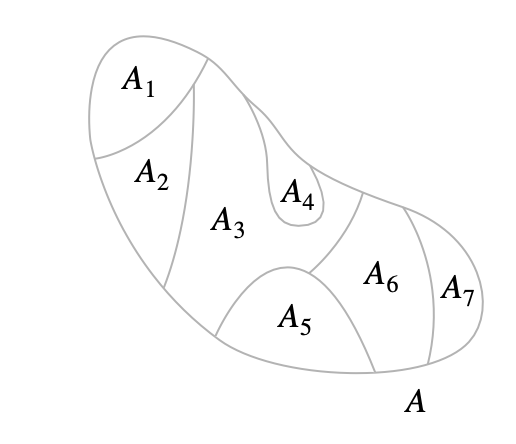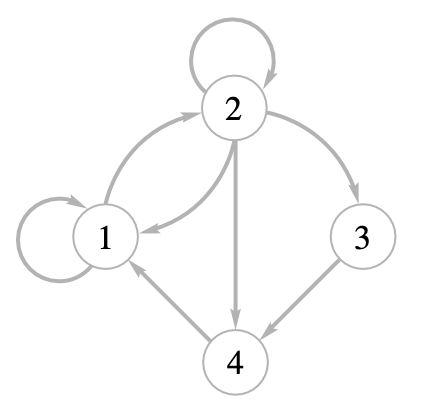Relations and Digraphs
Sources:
- Bernard Kolman, Robert C. Busby & Sharon Cutler Ros. (2014). Relations and Digraph. Discrete Mathematical Structures (6th ed., pp. 139-204). Pearson.
Orderd pair and list
- List:
- Suppose 𝑛 is a nonnegative integer. A list of length 𝑛 is an ordered collection of 𝑛 elements (which might be numbers, other lists, or more abstract objects).
- Note: A list has finite length since
- Note: A list has finite length since
- Two lists are equal if and only if they have the same length and the same elements in the same order.
- Suppose 𝑛 is a nonnegative integer. A list of length 𝑛 is an ordered collection of 𝑛 elements (which might be numbers, other lists, or more abstract objects).
- Ordered pair:
- An ordered pair
- Thus an ordered pair is merely a sequence of length 2.
- An ordered pair
Product Sets
If A and B are two nonempty sets, we define the product set or Cartesian product
Theorem:
For any two finite, nonempty sets
Proof:
Suppose that |A| = m and |B| = n. To form an ordered pair (a,b), a ∈ A and b ∈ B, 需要分别从A, B中选一个元素, 分别有m, n中可能, 因此
Example:
If
Partitions
A partition(划分) or quotient set(商集) of a nonempty set
- Each element of
- If
即: 集合
The sets in

- Since the members of a partition of a set
Example:
Let
Then
Also,
The collection
Example:
Let
Then
Relations
Let
If
If
Frequently,
Example:
Let
Example:
实数域的"等于"
Let
Example:
实数域的"小于"
Let
R = {(1,2),(1,3),(1,4),(1,5),(2,3),(2,4),(2,5),(3,4),(3,5),(4,5)}.
Sets Arising from Relations
Domain and Range
The domain of
In other words,
The range, or codomain of
Elements of
R-relative Set
Similarly, if
Note that
我们定义
- 当参数为元素
- 当参数为元素
THEOREM1
Let
- If
Proof
If
If
By the same argument, if
Conversely, since
If
THEOREM2
Let
Proof
If
由于每个
The Matrix of a Relation
We can represent a relation between two finite sets with a matrix as follows. If
The matrix
The Digraph of a Relation
Digraphs are nothing but geometrical representations of relations.
If
- 点
The resulting pictorial representation of
可以看到,
Example:
Let
Then the digraph of

In-degree & Out-degree
If R is a relation on a set A and a ∈ A, then
- The in-degree(入度) of
- The out-degree(出度) of
在图像上, 一个vertex的in-degree代表指向该vertex的edge, 而out-degree代表从该vertex出发的edge.
- Note that the out-degree of
Paths in Relations and Digraphs
A path is most easily visualized with the aid of the digraph of the relation. It appears as a geometric path or succession of edges in such a digraph.
Suppose that
A path of length
Note that a path of length
cycle(环): A path that begins and ends at the same vertex is called a cycle(环).
It is clear that the paths of length
- The set
- The set
- It is easily seen that
- It is easily seen that
路径的组合:
Let
Then the composition of
即: 如果有一条长度为m的路径
Theorem:
If
Proof:
Let
By definition of the matrix
翻译:
如果
这意味着:
- For brevity, we will usually denote
Theorem:
之前的结论可以推导到n>=2:
For
联系之前
Equivalence Relations
- equivalence relation(等价关系): A relation R on a set A is called an equivalence relation if it is reflexive, symmetric, and transitive. 即同时满足自反性, 对称性和传递性.
Example:
Let
Example:
Let
Equivalence Relations and Partitions
THEOREM 1: Equivalence Relation -> Partition
如果
Let
Then
Proof:
- If
- If
- If
因此
Since
THEOREM 2: Partition -> Equivalence Relation
反过来, 也可以用等价关系
Let
Then
Proof: According to the definition of a partition, we must show the following two properties:
- Every element of
- If
由于
接着证明性质2的逆否命题:
To prove this, we assume that
Since
Then
Lemma1已经证明了
We have now proved that
Lemma1
Let
Proof
充分性: 假设
必要性:
假设
- 由于
- 反过来,
- 综上所述,
Equivalence Class
equivalence class(等价类): If
- 这里的
- 划分
- 由于
- Some authors denote the equivalence class
Transitive Closure and Warshall's Algorithm
Transitive Closure
In this section we consider a construction that has several interpretations and many important applications. Suppose that R is a relation on a set A and that R is not transitive. We will show that the transitive closure of R (see Section 7) is just the connectivity relation